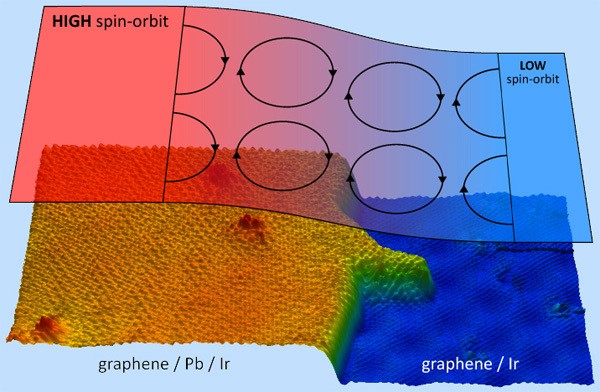LEAD ISLANDS IN A SEA OF GRAPHENE MAGNETISE THE MATERIAL OF THE FUTURE
A team of researchers, with the participation of DIPC and CFM Donostia (Centro Mixto CSIC-UPV/EHU), has discovered that if lead atoms are intercalated on a graphene sheet, the electrons behave as if they felt a powerful magnetic field.

This effect is due to the strong interaction of the electrons’ spin with their orbital motion that appears because graphene electrons “feel” the proximity of lead atoms. Paraphrasing Albert Fert, 2007 Nobel Prize in Physics, it is a type of spin-orbitronics. This is a novel direction of spintronics, an emerging technology promoted by the European Union to create advanced computational systems.
The researchers from Donostia International Physics Center (DIPC) and CFM Donostia −a joint centre between CSIC and the University of the Basque Country (UPV/EHU)−, together with researchers from IMDEA Nanociencia, Universidad Autonoma de Madrid (UAM), and Instituto de Ciencia de Materiales de Madrid (ICMM-CSIC) describe in the journal Nature Physics this week how to create a powerful magnetic field using this new material.
Graphene is considered as the material of the future due to its extraordinary mechanical, optical, and electronic properties, especially because of its high electron mobility. However, pristine graphene does not show magnetic properties and, so far, no definitive method has been found to manipulate its electrons (or any of their properties) to use it in new magneto-electronic devices.
Now scientists from Madrid and San Sebastian have come upon a key to do it: the intercalation of Pb atoms forming several nm wide islands below the sea of graphene electrons. As a consequence of the proximity of Pb atoms, an enormous increase of the spin-orbit interaction of graphene electrons takes place. To obtain this effect, scientists evaporate lead atoms on top of a graphene layer grown on an iridium crystal. Under certain conditions, lead atoms form ‘islands’ between the graphene layer and the top most Ir atomic layer, after having diffused across the graphene layer. In this way the pristine graphene electrons in p-bands close to the Fermi level behave as if they felt a colossal 80-tesla magnetic field, which facilitates the selective control of the flow of spins.
“This spin-orbit interaction is a million times more intense than that inherent to graphene, which is the reason why we obtain a revolutionary property that could have important use in technological applications, for example in data storage” explains Rodolfo Miranda, Director of IMDEA Nanociencia.
Spintronics is a new technology that uses electrons’ spin magnetic moment to store bits of information. It started with the discovery of giant magnetoresistance (GMR), a finding for which Peter Grünberg and Albert Fert were jointly awarded with the 2007 Nobel Prize in Physics. It is an effect that causes great changes in the electric resistance of fine multi-layer materials and has led to the development of components as varied as the reader heads on hard disks or the sensors in airbags.
The first generation of spintronic or magnetoresistant devices was based on the effect magnetic materials have on electron spin. But a second generation is already up and running, and encompasses this new study, in which electrons’ own spin-orbit interaction acts on them as if there were a real external magnetic field, even if there is not any. The use of graphene as an active component in spintronics is one of the principal aims of the large European Union project Graphene Flagship. Scientists’ final goal is to willfully control the type of spin the electrons in this new material have in order to apply it to the electronic devices of the future.



